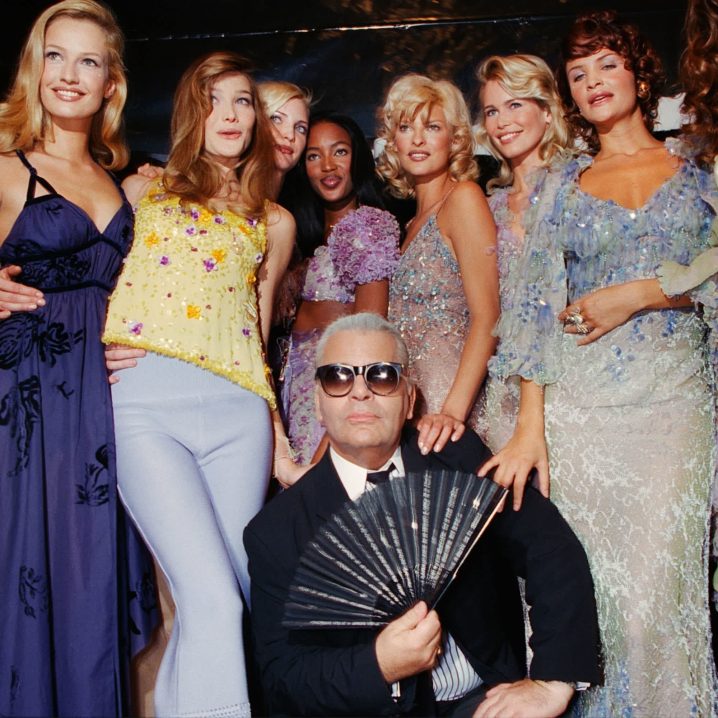
- POPSUGAR Australia
- Fashion
- Can Fashion Ever Really Be Inclusive?
Can Fashion Ever Really Be Inclusive?

Diversity and inclusion were big topics at Afterpay Australian Fashion Week.
After being very publicly called out by Vivien’s model Kate Wasley last year for lack of size diversity, efforts were made to represent a broad range of body types. Where last year Paralympian Rheed McCracken had trouble manoeuvring his wheelchair on the runway, this year we had Adaptive Clothing. The media coverage of AAFW this year suggested there was a sense that fashion’s relationship with diversity had taken a big step forward.
As a beauty writer, I didn’t spend Fashion Week in the front row. I was backstage with the models, makeup artists and hairstylists who became familiar faces over the week.
I’d rifle through kits, ask some questions, and then check Getty Images half an hour later to see how the looks came together. Seeing the model fully dressed on the runway, I could then understand how the hair and makeup direction served the story the designer was trying to tell. This isn’t the only way backstage is different to the front row. While a runway may seem pleasantly “diverse” from your seat, we know that models of all sizes, ethnic backgrounds, gender identities, sexual orientations and abilities have been treated appallingly while smiling for the camera.
I wondered what the models thought of the diverse runways they were participating in. After all, inclusion isn’t a spectator sport. It’s an experience.
Why Structural Inequalities Need to Be Addressed When Talking About Diversity
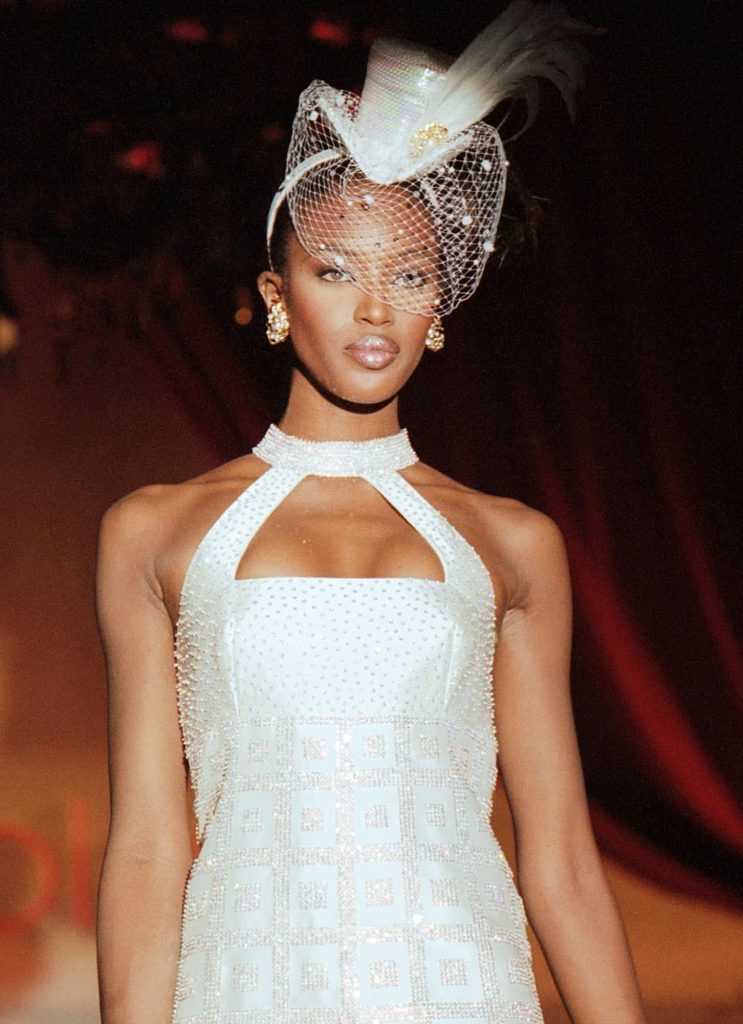
As many have noted, while marginalised groups are increasingly being welcomed into spaces that traditionally excluded them, those spaces often aren’t always supportive of them when they get there.
It’s the makeup chair that’s uncomfortable to sit in for a model who isn’t an Australian size 6, the hairstylist who can’t work with cornrows or the makeup artists who didn’t correctly match your foundation. The misuse of pronouns and the casual “joke” makes your stomach lurch, or the runway that isn’t wheelchair accessible.
When a model is booked, but backstage isn’t set up to receive them, that is when we encounter tokenism. Models as famous as Naomi Campbell have experienced this. Campbell spoke at a 2019 Wall Street Journal conference and referenced her experiences: “You’ve seen all shapes, sizes, colours, different hair types on the runway — we’re still in that,” Campbell said. “But now it needs to go deeper than that.”
But Can Fashion Go Deeper?
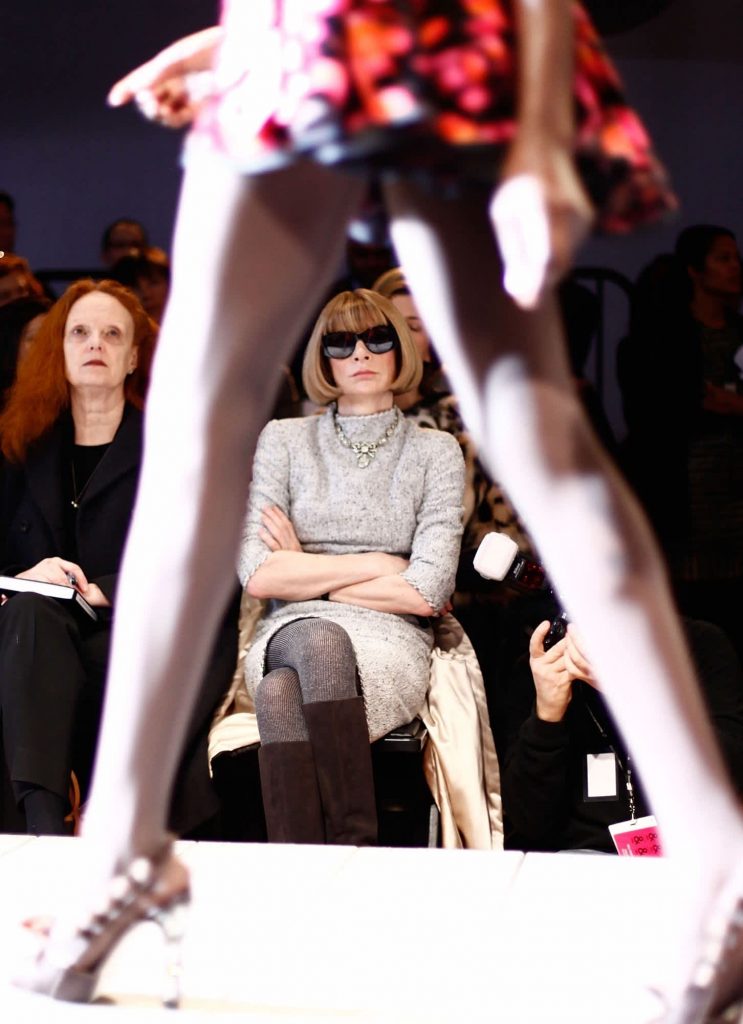
Fashion historically has drawn an equation between luxury and “exclusivity” or exclusion. The forms these exclusions take are varied. Sometimes it’s directed at the consumer, via exorbitantly expensive clothing and the promotion of aggressively unrealistic beauty ideals. Sometimes, it’s directed at the models and juniors who are notoriously exploited.
While the concept of luxury is now seen as outdated at best and offensive at worst, it’s deeply embedded in the framework and history of fashion.
In her book, The End of Fashion, author and Wall Street Journal reporter Teri Agens draws a direct line between the death of couture and the demand for practical and accessible clothing as women entered the workplace. Agens wrote, “Women want attractive clothes that function in the real world,” she described them as “clothes that fit your life.”
Now, there is an expectation that fashion will fit the lives of many more people than just cis, able-bodied (largely white) women entering corporate environments. But given inclusivity has always been seen as a “death” to luxury, can fashion sincerely accommodate this? The two are seen as so antithetical that media outlets like The Guardian question the viability of Anna Wintour’s career in a post-Black Lives Matter world.
It wasn’t until the final show of Fashion Week, First Nations Fashion and Design that I had time to talk with the models and glimpse how fashion could do things differently. It was the final show of a mammoth week. Many of the models, makeup artists, hairstylists and photographers had been on site since Monday.
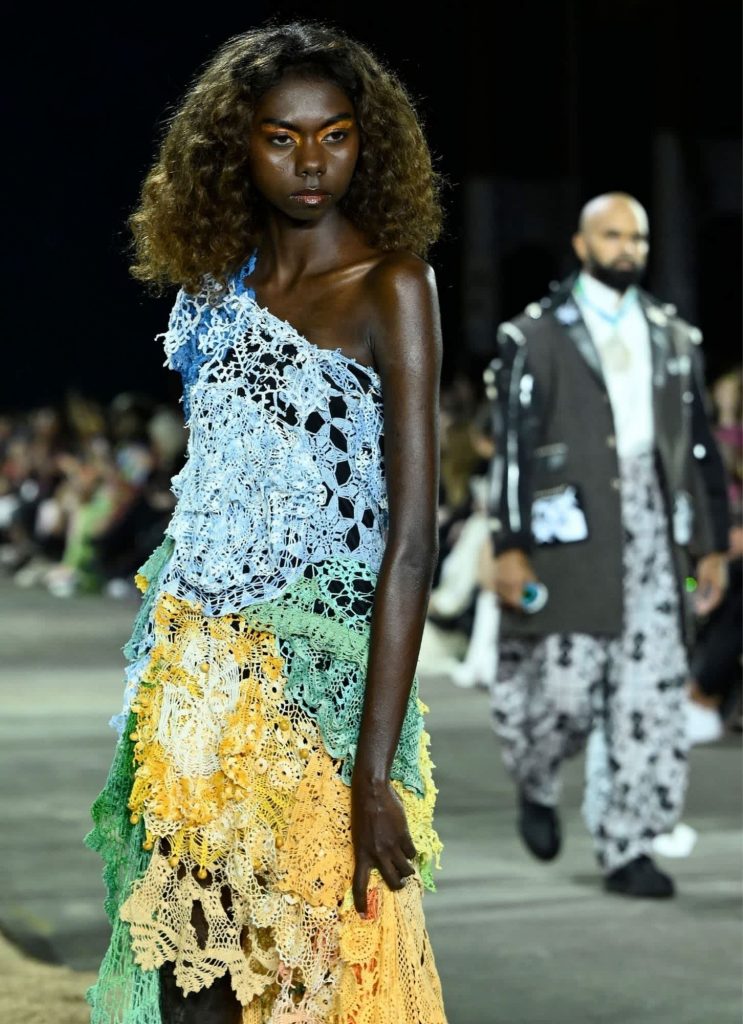
Other models had travelled from all over Australia to walk the show. Rising stars like Rembarrnga Dalabon, model and creative Cindy Renae Rostron and central Arrernte woman Savannah Kruger were present, as were new faces, like the ethereally beautiful Jack Williams.
First Nations Fashion and Design is a collective that represents Aboriginal and Torres Strait Islander creators in textile, design and the arts more broadly. Its mission is to create a self-sustaining ecosystem of creatives in design, textiles and jewellery, models, photographers, makeup artists and hairstylists. The runway featured beetle wing and wattle seed inspired couture creations of artist Paul McCann, alongside the emblazoned leisurewear from Clothing the Gap, and the intricate silken textiles of Ikuntji Artists. While hair and makeup were supported by Mecca Beauty and Redken, First Nations artists from FNFD like Kaydee Kyle-Taylor and Djahmu Claxton-Amini of Flock Hair worked backstage.
For Jack Williams, this was their first Fashion Week and first runway experience. Jack describes themself as a dancer, singer, model and queer, non-binary artist. They’ve had plenty of time on stage, whether as their larger than life alter-ego Diva D-lish or as a trained dancer with the NAISDA Dance College. They were encouraged to submit an application by models who’d worked with FNFD. Still, when they received the news, that they’d booked the FNFD runway they were… pretty nervous. Fashion Week and runways generally still carry all the connotations mentioned above. Jack tells me, “As a first-timer and fan of the industry, it was extremely intimidating. Knowing I would be in a room with professional models was nerve-wracking.”
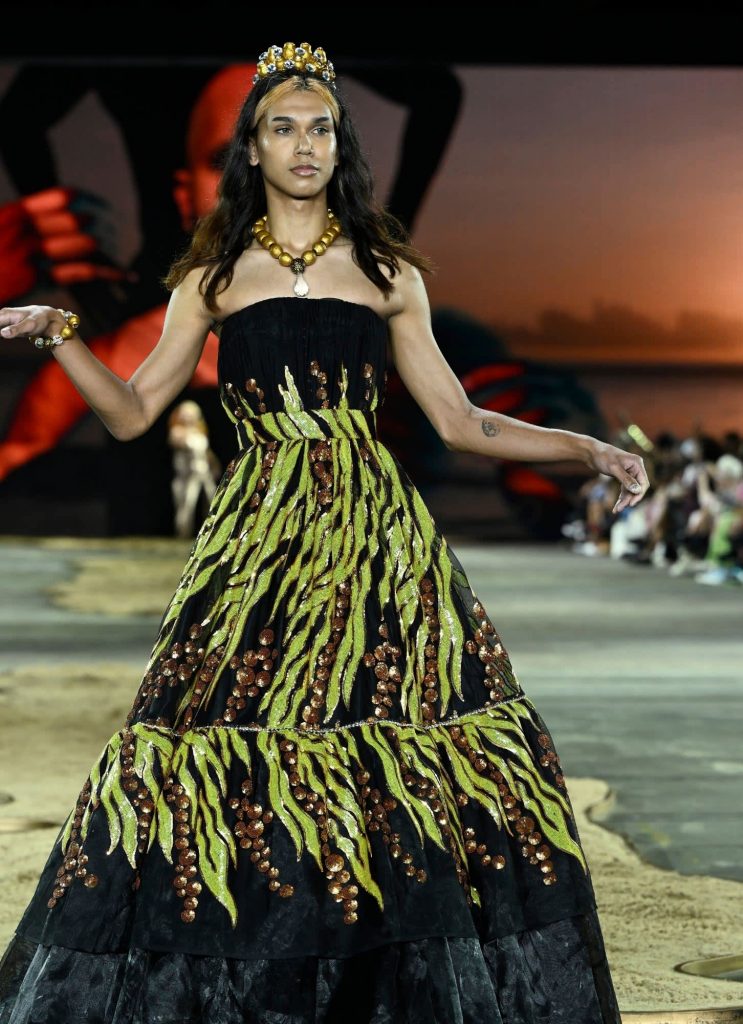
Jack said anxiety was assuaged by the team at First Nations Fashion and Design, the sense of community and collaboration backstage — and their genuine commitment to catering to the needs of a diverse cast. For Jack, this commitment was very tangible. “I wasn’t the only non-binary artist modelling at FNFD — there were pronouns on call sheets, signs and name tags which indicated how to refer to me, which really helped relieve stress and anxiety.” These practical, rather than symbolic approaches to inclusion have been recommended for a long time. Bell hooks wrote in her 1995 book Killing Rage: Ending Racism: “there must be a ‘practical model’ for social change focused on “an understanding of ways to transform consciousness that are linked to transforming structures.”
Jack said that the practical and structural measures taken in the show’s organisation meant that “everyone backstage understood that each other’s needs were.”
This understanding left room for one of the most creatively energising and collaborative backstages I’d witnessed all Fashion Week.
Here models seemed actively engaged in the process, chatting with designers and makeup artists, striking poses and discussing how they wanted their makeup and hair with stylists and MUAs. It was a distinct shift after a week of watching models sit staring at their phones (no foul on their part, I would also stare at my phone).
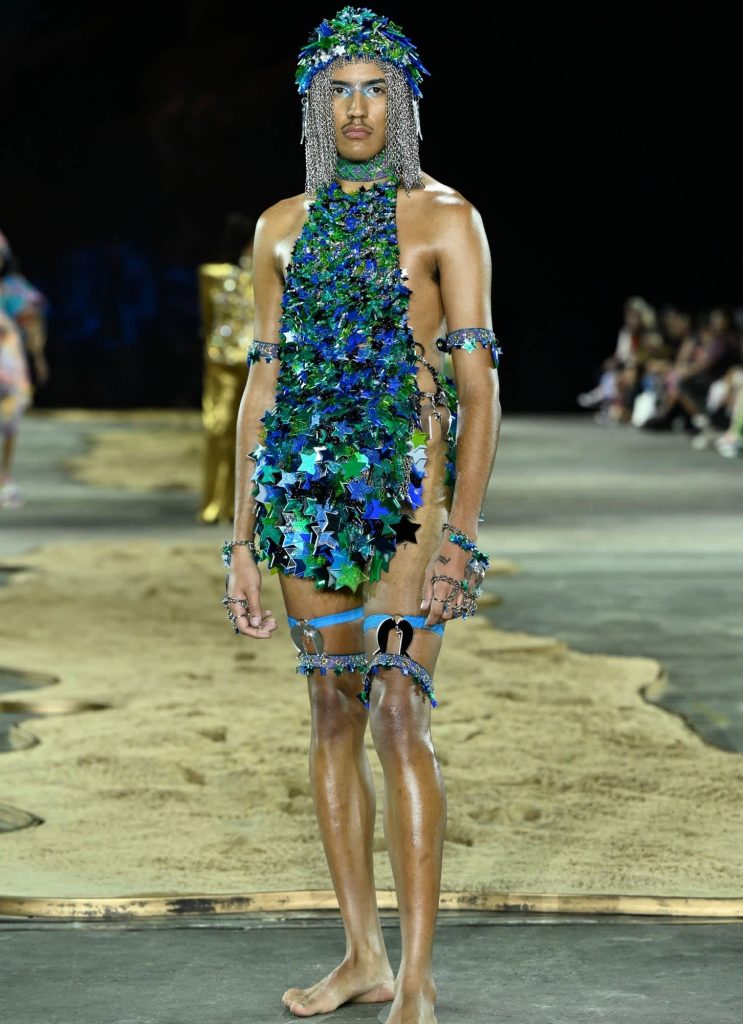
The show was called “Our Island, Our Home” and opened with a performance that addressed the climate-induced crisis affecting the Torres Strait islands, where, as reported by ABC, land is being submerged by changing weather and coastal erosion.
Jack described the feeling of shared purpose backstage.
“Being in a room with Black Mob and black icons was incredible. There was the best energy and space to work creatively — and exude black excellence,” they said.
The structure backstage seemed like a reversal of the traditional fashion hierarchy and a new way of working, one that integrates the perspectives and experiences of those who have been invited into the room.
Jack does believe that representation at mainstream events is essential — particularly for the first nations LGBTQI community, who are often invisible in conversations around First Nations experience, and public policy.
“I’ve been in spaces, many times, where there is judgement from people who aren’t educated on all aspects of LGBTQI+ identity,” Jack notes that many people, for instance, still confuse sexual orientation and gender identity — “because they are simply not familiar with it.”
They believe that events like AAFW set norms and are significant opportunities to shift the dial. “Representing Queer Black Mob, in the best possible way, at an event like AAFW educates a much larger audience.”


